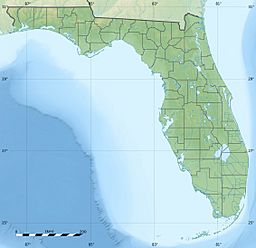Lake Santa Fe facts for kids
Quick facts for kids Lake Santa Fe |
|
|---|---|

Lake in January 2020
|
|
| Location | Alachua County, Florida |
| Coordinates | 29°44′22″N 082°04′33″W / 29.73944°N 82.07583°W |
| Primary inflows | springs |
| Primary outflows | Santa Fe River |
| Basin countries | United States |
| Surface area | 5,850 acres (2,370 ha) |
Lake Santa Fe is a large lake in Alachua County, Florida. It covers about 5,850 acres. This lake gets its water from underground springs, which are part of the huge Floridan Aquifer system.
Lake Santa Fe is special because it's the beginning of the Santa Fe River. The river flows out from a smaller northern part of the lake, called Little Lake Santa Fe. Eventually, this river joins the Suwannee River.
Contents
A Great Place for Fun and Fish
Lake Santa Fe is known for its amazing wildlife and is a fantastic spot for fishing and boating. It's one of the biggest and most stable lakes in all of Florida. This means its water levels usually stay pretty steady.
Fishing in Lake Santa Fe
If you love fishing, Lake Santa Fe is a great choice! You can often find lots of fish near "the pass," which is the narrow area connecting the main lake to Little Lake Santa Fe. Here, you might catch largemouth bass and sunshine bass.
Even though many homes are built around the lake, the fish still have excellent places to live. There are many areas with tall bald cypress trees and healthy beds of maidencane grass. These plants provide perfect hiding spots and food for fish. In 2005, the lake was stocked with 44,500 hybrid striped bass to boost the fish population.
Clear and Stable Waters
Lake Santa Fe is one of the clearest lakes in Florida. It's also one of the most stable, meaning its water levels don't change much. The state of Florida has even named it an Outstanding Florida Water. This special title means the lake's water quality is very high and needs to be protected.
The lake is also quite deep in some spots, going down 30 feet (9 meters) or more. It's a type of lake called a karstic lake, which means it formed in areas where limestone bedrock has dissolved over time.
History of the Canals
Long ago, in the 1870s and 1880s, Lake Santa Fe was part of a big project. People dug canals to connect it to other lakes. This allowed boats to travel between Melrose, Florida, a busy town at the time, and Waldo, Florida, where there was a railroad.
Traveling by Water
These canals made it possible for people and goods to travel across Florida by water and railroad. The first boat to use this canal system was called the "Fannie S. Lewis" in 1880. The last boat, the "City of Melrose," sailed through in 1925.
However, as better roads were built and automobiles became popular, people stopped using the steamships. The canals were no longer needed and fell out of use.
Nearby Communities and Nature
The small, rural communities of Melrose and Earleton are located right on the lake. North of the lakes is the Santa Fe Swamp. This area is mostly a wildlife and environmental conservation area. It is managed to protect nature and animals by the Suwannee River Water Management District.



